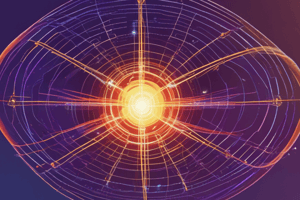Podcast
Questions and Answers
What does Coulomb's law state about the electrostatic force between two point charges?
What does Coulomb's law state about the electrostatic force between two point charges?
- It is directly proportional to the product of the magnitudes of their charges and inversely proportional to the squared distance between them. (correct)
- It is inversely proportional to the product of the magnitudes of their charges and directly proportional to the squared distance between them.
- It is directly proportional to the squared distance between them and inversely proportional to the product of the magnitudes of their charges.
- It is inversely proportional to the squared distance between them and directly proportional to the product of the magnitudes of their charges.
What did Coulomb discover about the repulsive force between bodies with like electrical charges?
What did Coulomb discover about the repulsive force between bodies with like electrical charges?
- It is directly proportional to the square of the distance.
- It follows the inverse proportion of the square of the distance. (correct)
- It is directly proportional to the distance.
- It is inversely proportional to the distance.
In Coulomb's law, what does 'ke' represent?
In Coulomb's law, what does 'ke' represent?
- The product of the magnitudes of the charges
- The charge of one of the particles
- A constant (correct)
- The distance between the charges
What is the formula for the electrostatic force between two point charges according to Coulomb's law?
What is the formula for the electrostatic force between two point charges according to Coulomb's law?
What is the significance of Coulomb's law in the development of the theory of electromagnetism?
What is the significance of Coulomb's law in the development of the theory of electromagnetism?
What does Coulomb's law state about the electrostatic force between two point charges?
What does Coulomb's law state about the electrostatic force between two point charges?
What did Coulomb discover about the repulsive force between bodies with like electrical charges?
What did Coulomb discover about the repulsive force between bodies with like electrical charges?
What is the formula for the electrostatic force between two point charges according to Coulomb's law?
What is the formula for the electrostatic force between two point charges according to Coulomb's law?
Who first published Coulomb's law?
Who first published Coulomb's law?
What is the significance of Coulomb's law in the development of the theory of electromagnetism?
What is the significance of Coulomb's law in the development of the theory of electromagnetism?
Flashcards are hidden until you start studying
Study Notes
Coulomb's Law
- Coulomb's law states that the electrostatic force between two point charges is proportional to the product of the magnitudes of the charges and inversely proportional to the square of the distance between them.
- Coulomb discovered that the repulsive force between bodies with like electrical charges is proportional to the product of the magnitudes of the charges and inversely proportional to the square of the distance between them.
- In Coulomb's law, 'ke' represents the Coulomb constant, which is a constant of proportionality.
- The formula for the electrostatic force between two point charges according to Coulomb's law is F = (ke * q1 * q2) / r^2, where F is the electrostatic force, q1 and q2 are the magnitudes of the two point charges, and r is the distance between them.
- Coulomb's law is significant in the development of the theory of electromagnetism because it provides a fundamental understanding of the electrostatic force between charged objects and has been widely used to describe the behavior of electrically charged particles.
- Charles-Augustin de Coulomb first published Coulomb's law in 1785.
Studying That Suits You
Use AI to generate personalized quizzes and flashcards to suit your learning preferences.





